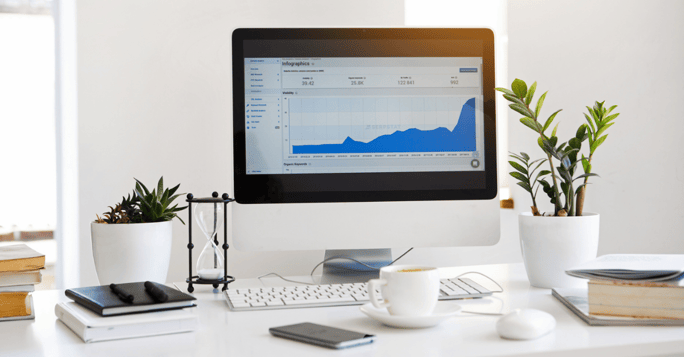


Measuring your digital workplace ROI will allow you to make better business decisions for your organization. Driving efficiency, improving the customer experience, engaging key employees and increasing productivity are metrics that will remain at the top of every business leaders’ agenda.
Digital technology is likely to be at the forefront of this. In fact, in May this year, Fortune published the results of a 500 CEO survey which looked at how America’s biggest companies are dealing with the pandemic. A staggering 75% believe that the pandemic will accelerate a companies’ technological transformation.
Whether it’s a social intranet or a digital workplace, enabling your workers to understand and engage with your priorities using any digital device in every location is already at the forefront of this revolution. In the current environment, achieving and demonstrating a good return on investment from your digital workplace is critical.

While it’s usually easy to track metrics such as the number of ‘views’ and ‘likes’ associated with key pages or content on your digital workplace platform itself, this alone may not provide the quality or level information you are looking for.
A more strategic approach to defining your ROI is to start with the business reasons you have introduced a digital workplace tool in the first place. Without an alignment to your business goals, your intranet won’t deliver value, leaders will become disinterested and adoption will suffer.
For example, if your strategic business goal is to expand globally, your metrics need to test how your intranet is supporting employees through collaboration across time-zones, use of translation features and mobile access. If your organization aims to encourage innovation and creativity, your metrics will need to correspond to the way your intranet supports idea generation.
Some business goals are also easier to measure than others. For example, hard metrics like employee retention, or an increase in sales are based on hard numbers. Other goals such as improved employee engagement, collaboration, relationships and ideation – which are many of the most important aspects of digital communities are harder to quantify. Nonetheless, being very clear about what you are seeking to measure is critical to understanding your ROI and proving the value of your Digital Workplace.
Once you are clear about the business outcomes you are seeking to achieve, you can develop measurement methods and metrics to test them.
Measurement methods include using data analytics tools such as Power BI, regular online ‘pulse’ surveys to understand knowledge gaps around key organizational topics, employee engagement surveys and focus group activity to assess the impact of the digital workplace on key business priorities in different departments and office locations.
There are a myriad of easy ways to collect data about your digital workplace, but the tricky part is choosing the data that accurately represents business value at your organization. For this reason, data points tend to be both quantitative and qualitative.
Best practice is to measure ‘lead indicators’ to test whether workers have received, understood or retained specific information, as well as the likely impact on your business goals including the changes to attitudes or behaviors that have been achieved. This includes productivity, innovation, collaboration, customer focus, cost savings etc.
There are many metrics that can be measured but when it thinking about your Digital Workplace ROI, here are our top 5:
1. General Usage
Specific metrics such as views, visits, likes, comments, etc. provide a general indication of how many people are using the tool, and they can be tracked over time. This data makes it easy to see employee usage trends and the type of content they are viewing, which is in itself an indication of employee engagement.
You may also want to track usage numbers relating to specific devices, such as mobile phones as a way of measuring the impact of your digital workforce on remote employees. All of this information can be very easily obtained using common data analytics tools such as Power BI and Google Analytics.
2. Top Users
Many organizations find that some workers use their digital workplace considerably more than others. It’s important to leverage their skills and enthusiasm as these employees are likely to influence others and are often proactive in helping to drive local adoption.
This group can also provide tangible feedback into what they like, what they don’t like, and what they may like to see changed, which in turn will drive your digital workplace ROI.
3. People-related business metrics
A very tangible way to measure the ROI of your digital workplace is to track metrics that relate to people within your organization. Sharing this data with HR will often lead to improved Digital Workplace advocacy.
Examples of metrics to track include:
4. Cost related business metrics
Finance departments are likely to be very interested in understanding your digital
workplace ROI. Measuring efficiency is a good way to get these important stakeholders on board. Examples of metrics to track include:
5. Customer and Sales related metrics
Customers are the lifeblood of most organizations and your digital workplace is a great way to ensure your Salesforce has the confidence and information available to deliver a good customer experience and drive more sales. Examples of metrics to track include:
Measuring the digital workplace ROI is critical, but there is seldom a one-size-fits-all approach. Defining the most important business outcomes for digital transformation and making sure that you have the right metrics in place to evaluate your success is the best place to start.
Remember that when collecting data, it’s easy to feel overwhelmed by the increasing amounts of data being collected, so use it wisely.
These Stories on digital workplace

No Comments Yet
Let us know what you think